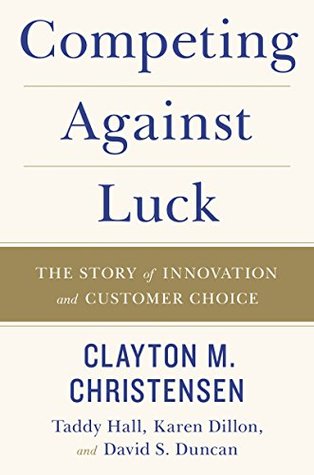More on this book
Community
Kindle Notes & Highlights
circumstance from the perspective of the consumer with the Job to Be Done,
the job spec is from the innovator’s point of view: What do I need to design, develop, and deliver in my new product offering so th...
This highlight has been truncated due to consecutive passage length restrictions.
The job spec then becomes the blueprint that translates all the richness and complexity of the job into an actionable guide for innovation.
it’s in this level of detail that organizations create long-term competitive advantage
this is how customers decide what products are better than other products.
an illustration with my students to highlight how to think about innovating around jobs.
That involves not only understanding the job, but also the right set of experiences for purchase and use of that product, and then integrating those experiences into a company’s processes.
Uncovering the Job, Creating the Desired Experiences, and Integrating around the Job—are
The reason why we are willing to pay premium prices for a product that nails the job is because the full cost of a product that fails to do the job—wasted time, frustration, spending money on poor solutions, and so on—is significant to us.
not only financially, but also in personal resources.
You can only shape the experiences that are important to your customers when you understand who you are really competing with.
Creating experiences and overcoming obstacles is how a product becomes a service to the customer, rather than simply a product with better features and benefits.
The question of paying for a pacemaker and the attendant medical services was no small concern. So Medtronic created a loan program to help patients pay for the pacemaker procedure.
Not an obvious thing to do! However, diagnosing problem not just technical but also barriers to "hire" your solution creates guiding policy and this action is coordinated with solving the customer experience!
The value of creating the right set of experiences in a circumstance-specific job is clearly not universally understood.
Failing to deliver the experiences that help your customers solve their Jobs to Be Done leaves you vulnerable to disruption as better solutions come along and customers swiftly jump ship.
The experiences that come with hiring Uber to solve customers’ Jobs to Be Done are better than the existing alternatives. That’s the secret to its success.
Uber isn’t just competing with taxis and car services, it’s also competing with opting to take the subway home or calling a friend.
Organizations that focus on making the product itself better and better are missing what may be the most powerful causal mechanism of all—
what are the experiences that customers seek in not only purchasing, but also...
This highlight has been truncated due to consecutive passage length restrictions.
Businesses now have to consider how to educate customers about what job these products and services are designed to do2—and when potential customers should not consider hiring them. That is a new wrinkle.
Purpose brands play the role of communicating externally how the “enclosed attributes” are designed to deliver a very complete and specific experience.
When competitors successfully enter markets that seem closed and commoditized, they do it by aligning with an important job that none of the established players has prioritized.
This was not built through advertising. It was built through people hiring the service and finding that it got the job done.
The guiding
Purpose brand makes very clear which features and functions are relevant to the job and which potential improvements will ultimately prove
The specific details of the job, and the corresponding details of your solution, are critically important to ensure a successful innovation.
job spec, which includes the functional, emotional, and social dimensions that define the desired progress; the tradeoffs the customer is willing to make; the full set of competing solutions that must be beaten; and the obstacles and anxieties that must be overcome.
Complete solutions to jobs must include not only your core product or service, but also carefully designed experiences of purchase and use that overcome any obstacles a customer might face in hiring your solution and firing another.
successfully nail the job,
transform your company’s brand into a purpose brand,
one that customers automatically associate with the successful resolution of th...
This highlight has been truncated due to consecutive passage length restrictions.
successful growth companies optimize around the job.
Competitive advantage is conferred through an organization’s unique processes: the ways it integrates across functions to perform the customer’s job.
Processes can profoundly affect whether a customer chooses your product or service in the long run. And they may be a company’s best bet to ensure that the customer’s job, and not efficiency or productivity, remains the focal point for innovation in the long run.
“If you can’t describe what you are doing as a process, then you don’t know what you are doing.”
Toyota’s competitive advantage rested firmly in its proprietary, complex, and often unspoken processes.
I think they recognized we were asking the wrong questions. We didn’t understand this bigger picture.”
a critical part of the unspoken culture of an organization.
Processes are intangible; they belong to the company. They emerge from hundreds and hundreds of small decisions about how to solve a problem.
the right job spec leads to the right processes that will generate the right data to know “How are we doing?” Jobs Theory focuses you on helping your customers do their
Correctly diagnosing and having a guiding policy to respond to the job will guide coordinated actions AND identify important measurables of successfully performing the job to be done


